Paper Planes - Learn Mix, Bass, Beat
MIA’s genre-smashing music production and song writing style has finally elevated her to mainstream stardom. Like J Dilla, MIA has been a favorite of seasoned producers ever since the release of her first CD, Arular. Her newest hit song, Paper Planes off her 2007 release, Kala, is the result of the collaborative efforts of MIA, Wesley Pentz (a.k.a. Diplo), and Dave Taylor (a.k.a. Switch). It first gained notoriety as the soundtrack to the Pineapple Express movie trailer, and has been covered, remixed, and sampled over and over by such notable performers as Rihanna, Wayne, TI, Jay-Z, 50, and others. Not only has Paper Planes soared high and far on Billboard’s Hot 100, but it has steadily climbed charts all over the world. Contradictory and controversial at every level, Paper Planes is a high-flying sign of the times. In this preview of the full Hit Report (available for purchase at the bottom of this page,) we explain the mix frequency separation as well as aspects of the drum production.
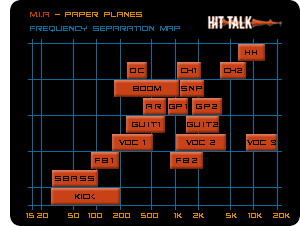 |

Mix & Frequency Separation
Like all MIA’s songs, Paper Planes is a pleasing sonic challenge for the listener. The song was written by MIA and Diplo, while Switch oversaw the final stages of mixing and fine-tuning. There are several sly tricks in this mix. Let’s start with the bass range and work on up. The kick occupies the typical sub-bass range between 30Hz. The next song element is the sub bass (sbass) which is a sine wave played on a synth. The sub bass plays the root notes underneath the finger bass (fb1 & fb2) The two divisions of the finger bass represent the root notes (fb1) and the fret noise and twangy tone of the bass (fb2). The bass production gives us our first clue that this Billboard hit is going to be a raw-sounding song. For all its tonal character, the finger bass might as well be a 99 dollar Wal-Mart special. The bass has a flat timbre and the bass strings are buzzing against the frets. It sounds like it could be made out of plywood.
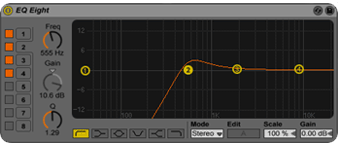 Even if the bass were an expensive Warwick or Fender, this bass timbre could be achieved with some adjustment to the signal. But why would you want to make the bass sound trashy in the first place? Because the bass timbre, like the song’s guitar hook, is borrowed from The Clash’s Straight to Hell. Since that bass sound is part of what defines the sound of Straight to Hell, it makes sense to pay it respect by reproducing it faithfully, and accurately. All you need to produce this timbre is some fret buzz and a highpass filter to knock out the low frequency resonance, or tone, of the bass. A highpass filter with a medium Q setting at about 500 Hz will give a very similar result. Though this provides the desirable raw sound, it also creates a problem: an electric bass whose low-frequencies have been hollowed out creates a void in the frequency spectrum. There’s no low bass frequency range, except for the kick drum (kick), and that’s why the sub bass that we mentioned above was added to the mix. A sine wave bass synth was a necessary addition to fill out the bass frequency spectrum. The sub-bass sine wave provides low bass presence, playing the root notes of the song in long sustained notes, while the rhythm is held together by the finger bass. Thus, the job of bassline has been divided between two different instruments: a trashy sounding finger bass, and a low frequency-rich sub synth. This maneuver creates a sound that replicates the original Straight to Hell bassline, but that also adds the full mix demanded by today’s listeners.
Even if the bass were an expensive Warwick or Fender, this bass timbre could be achieved with some adjustment to the signal. But why would you want to make the bass sound trashy in the first place? Because the bass timbre, like the song’s guitar hook, is borrowed from The Clash’s Straight to Hell. Since that bass sound is part of what defines the sound of Straight to Hell, it makes sense to pay it respect by reproducing it faithfully, and accurately. All you need to produce this timbre is some fret buzz and a highpass filter to knock out the low frequency resonance, or tone, of the bass. A highpass filter with a medium Q setting at about 500 Hz will give a very similar result. Though this provides the desirable raw sound, it also creates a problem: an electric bass whose low-frequencies have been hollowed out creates a void in the frequency spectrum. There’s no low bass frequency range, except for the kick drum (kick), and that’s why the sub bass that we mentioned above was added to the mix. A sine wave bass synth was a necessary addition to fill out the bass frequency spectrum. The sub-bass sine wave provides low bass presence, playing the root notes of the song in long sustained notes, while the rhythm is held together by the finger bass. Thus, the job of bassline has been divided between two different instruments: a trashy sounding finger bass, and a low frequency-rich sub synth. This maneuver creates a sound that replicates the original Straight to Hell bassline, but that also adds the full mix demanded by today’s listeners.
To summarize the rest of the mix, MIA’s voice occupies the alto range. We’ve divided up the vocals into fundamental notes, harmonics, and treble consonants (voc1, voc2, and voc3, respectively). Also, in the alto range, are the guitar hook (guit1 and guit2 represent root notes and higher harmonics) and the ambient ringing synth pad (ar) from the introduction. Next, gp1 and gp2 refer to one of the song’s key features: the processed guitar sample that joins the arrangement in the first verse. Hi-hats (hh) occupy their typical range in the upper spectrum.
Drum Production at a glance
For those interested in producing beats, Paper Planes has much to teach. The hi-hat line and bass line, in particular, are two of the most interesting parts of the song’s beat. Here, we provide you with a taste of the kind of analysis you get with our full Hit Reports.

Above is a small preview of the new Track Detail Map that we’ll be using to illustrate finer details of beat production, song production, and song arrangement. The full Paper Planes Track Detail Map spans 4 bars of the hook, 4 bars of the verse, and shows the details of 6 tracks of Paper Planes. In this preview, you’re seeing a part of the hook, and all 4 bars of the verse. The red lines represent each bar (numbered at bottom) and the gray lines represent 8th notes. The first track shows the hi-hat pattern panning from left(bottom) to right (top).In each bar, the “1 &,” and “3 &” counts occur in the left channel, where the “a 2 e & a” counts between the 1 and 3 appear in the right channel. In addition to panning, the hi-hat pattern is made more interesting because of the single 16th note rest on the 4 count, a subtle evolution that, with the panning, gives the hi-hat pattern both an interesting stereo image and evolving rhythm.The second track shows how the kick drum pattern evolves during the verse. Notice in the 3rd bar of the verse (the 3rd bar of the 2nd section of the kick track), one 16th note has been added. On its own, it’s not a large change, but many subtle evolutions in every track create a dynamic, evolving structure that sustains a listener’s interest. To find out a whole lot more about how Paper Planes is put together and what it can teach aspiring and experienced producers, download the full report below.
Order the full “Paper Planes” Hit Report & Get it all… |
|
 Paper planes Song Format Map! (View All) Paper planes Song Format Map! (View All) Paper Planes Frequency Separation Map! (View All) Paper Planes Frequency Separation Map! (View All) Paper Planes Song Arrangement Map! (View All) Paper Planes Song Arrangement Map! (View All) Paper Planes Groove Analysis Map! (View All) Paper Planes Groove Analysis Map! (View All) Paper Planes Track Detail Map! (View All) Paper Planes Track Detail Map! (View All) Paper Planes Song Arrangement Step-by-Step Report! Paper Planes Song Arrangement Step-by-Step Report! Paper Planes Mix & Frequency Separation Report! Paper Planes Mix & Frequency Separation Report! Paper Planes Music Production Report! Paper Planes Music Production Report! Paper Planes Vocal Production Report! Paper Planes Vocal Production Report! Paper Planes Drum Production Report! Paper Planes Drum Production Report! Paper Planes Hook Production Report! Paper Planes Hook Production Report! Paper Planes Compression Report! Paper Planes Compression Report! Paper Planes Effects Report! Paper Planes Effects Report! Super Bonus: VIPKIT#19, 110 Samples, $30 value! Super Bonus: VIPKIT#19, 110 Samples, $30 value! |
|
| Enhance Your Music Production Skills Today! |
|







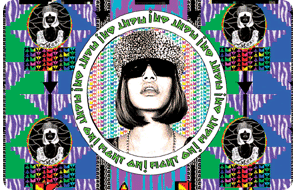

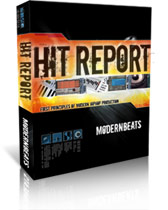
 GET 20% OFF COUPON INSTANTLY W/ SIGN-UP!
GET 20% OFF COUPON INSTANTLY W/ SIGN-UP!
 Check Out Hot Artists & Music Producers discovered through Song Submit!
Check Out Hot Artists & Music Producers discovered through Song Submit!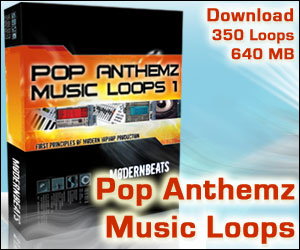
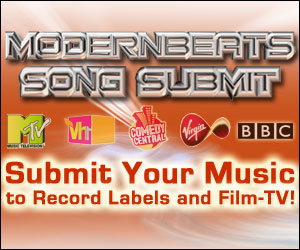


i wuld like u to recoomend te best soft ware for my beat production.well i ve gone 2ru ur stuffs n i fink it is damn cool hence i wuld luv u 2 assit me as regards the soft ware.n pls kip sendin me enough tips.i wuld like to know wat an average or home studio shud look like as in wat shud b in tha studio.thanks
The best software? That’s a huge question, Deybur, but thanks for asking. If your budget is lower and you think you’re going to need a lot of guidance, Image Line FL Studio is a great choice, because it’s inexpensive, comprehensive, and, once you’ve registered with Image Line, you get dozens of great videos teaching you how to use the program.
Reason and Ableton Live are also great, intuitive programs - easy to understand if you’re a beginner because they do a lot of the work automatically. Cubase and Sonar, by contrast, are programs that are geared more toward conventional recording; they’re easier to understand if you’re coming at beat production with the mindset of a recording engineer. And there really is no average home studio. We cover basic studio setups in the Hit Theory ebook (see link at top of page). Thanks for your question.
well basically i want to know what are some good web sites to upload my beats for others to hear i have soundclick and beta records web sites are there anymore cause i’m ready for the world to hear my style please help
Hi Dameon,
One very excellent site that we work with frequently is Broadjam. They take a pretty active role in helping artists gain exposure. There’s a membership fee, but you can get a free 6-month primo membership to Broadjam by buying our Hit Theory ebook (actually cheaper than membership): Check it out
I have been searching and searching all over the internet for those chants and screams you would hear in hip hop songs.For example that HEY! …HEY…HEY that you hear in alot of crunk music.Could someone pleeeeeease tell me where to find these vocal chants??
meekz23 you could search for a sample, but if you had a mic booth - that would be someone actually saying it. It may be heavily processed on occasions, but you can use the same sample all the way thru the track. Jeezy sounds the best for this!
Meekz23, I think this is what you need: the Vox Chants library by MB
https://www.modernbeats.com/vox-chants-vocal-samples.php
just what you’re looking for.
I’m not trying to get anywhere big right now but i just want to start out rap songs to see how it is.